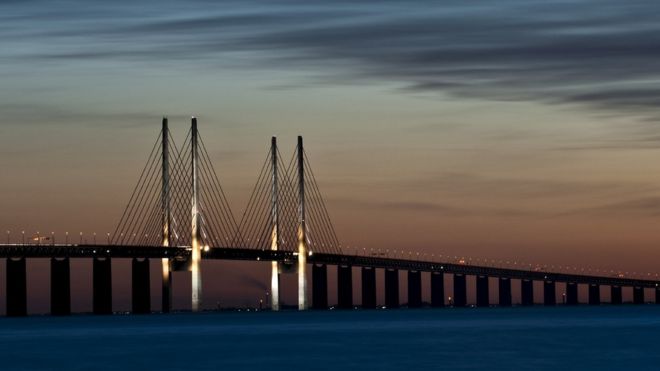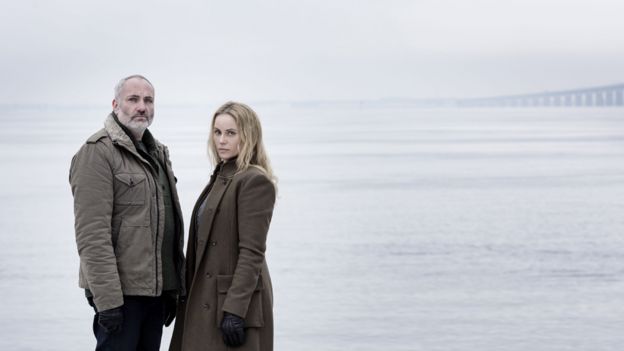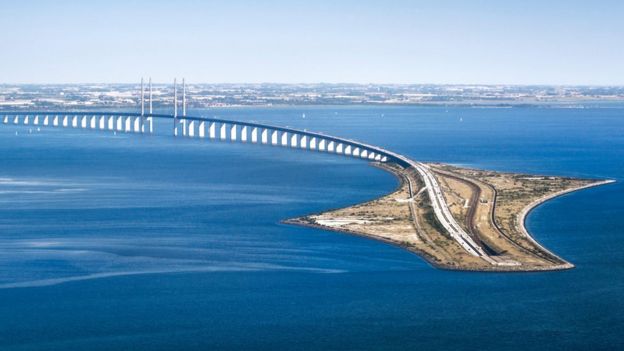The real story of the Bridge
- 5 January 2016
- Magazine
 iStock
iStock
The bridge which links Sweden and Denmark, is recognised the world over thanks to a hit TV drama. For many, it sums up the ease with which people have been able to travel between the two countries, but new rules mean it will take longer to cross.
It's the backdrop for The Bridge, one of the moodiest TV series in recent years - the Oresund Bridge is plunged into darkness when a body is left lying across the exact point where Denmark and Sweden meet. The road becomes a crime scene and police from both sides of the border realise they must work together to track a killer.
As fictional detectives Saga Noren and Martin Rohde hunt the murderer, the viewer gets the impression that nipping from one country to the other is quick and easy - although the two cultures differ, the bridge acts as a symbol of their closeness.
The drama, first shown in 2011, has been broadcast in more than 100 countries and the structure is undoubtedly one of the stars of the show.
 BBC/ZDF/Carolina Romare
BBC/ZDF/Carolina Romare
But nipping across the bridge will now take much longer. Stockholm has introduced identity checks for travellers from Denmark to try to reduce the number of migrants arriving in the country - Sweden received more than 150,000 applications last year.
It's not just a road bridge, though - the 16km (10 miles) link across Oresund, a strait between Sweden and Denmark that's known for its rough weather, is also part tunnel and part island. It cost 30bn Danish krone ($4.3bn; £3bn) and was built in just five years, opening in June 2000.
It shortens journeys between the Danish capital of Copenhagen and the Swedish cities of Malmo and Lund to just over half an hour by train. It takes about 10 minutes to drive across.
The bridge itself is about 8km (five miles) long. A high-speed railway runs on a deck beneath the E20 road and there's space for ships of up to 57m in height to pass underneath.
 iStock
iStock
An estimated 20,000 commuters use the crossing every day. "The views are impressive," says Spyros Sofos, a lecturer at Sweden's Lund University, who commutes via rail across the Oresund a few times a week and uses the road for shopping trips. "There are wind farms in the distance as you cross. At night you can see the lights of the cities.
"You get a sense of the engineering. The bridge is clearly visible from the beach in Malmo. It's the sort of structure, both in terms of size and design, that you can't ignore."
After the Danish and Swedish governments signed an agreement in 1991 to build a permanent link across the Oresund, a problem arose. At the Danish end, any bridge high enough to allow large ships through would pose a threat to planes landing at nearby Kastrup Airport. However, building it too low would block a busy maritime route.
So it was decided that this end of the link would, instead, consist of a concrete tunnel, with an artificial island connecting it to the bridge. The tunnel and the island are each approximately 4km (2.5 miles) long.
 Alamy
Alamy
The island, named Peberholm, was constructed from the material dredged from the seabed to accommodate the bridge, which is edged by rocks quarried in Sweden. It's now an unpopulated nature reserve, popular with green toads, and its completion increased the landmass of Denmark by 1.3 million square metres.
The Oresund link connects the greater Copenhagen and Malmo areas, which together are home to 3.5 million people. For car drivers, a single trip costs from 14 euros ($15; £10) for the most frequent users to 48 euros ($52; £35) for those making a one-off crossing.
The new identity checks are likely to make the journey less pleasant. It's thought they could add half an hour to rail trips, with Danish Prime Minister Lars Loekke Rasmussen predicting the measures could cause serious disruption to traffic flows from Denmark.
Sofos says the checks add at least an extra 30 minutes to his rail commute, with officials boarding trains to check travellers' documents shortly after they enter Sweden. "I've seen people being arrested," he adds. "Before these checks, travel across the Oresund was seamless."
Creating a permanent crossing of the Oresund was a dream for many years before the final project got going. In 1888 there was a proposal to install a railway tunnel across a narrower section between Elsinore in Denmark and Helsingborg in Sweden, but this didn't happen. Neither did plans for a bridge revealed shortly after World War Two.
Even when building got under way in 1995, British bombs used in World War Two were found on the sea bed and had to be removed.
"We are going several steps back in time," says Michael Randropp, of the commuters' association in Kystbanen, on the Danish side of the Oresund. He's not happy with the new border checks: "It's as if we are building a Berlin Wall here."
A role model for women with autism

Saga Noren from the Scandinavian TV crime drama The Bridge has become an unlikely hero. Widely diagnosed by viewers as being on the autistic spectrum, she is lauded not just because she is a leading character with the condition, but - more unusually - because she is a woman with it.

No comments:
Post a Comment